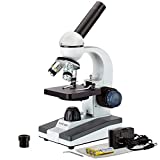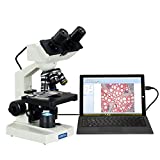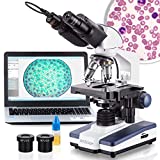Microscopes for viewing bacteria – Buying Guide & Comparison
If you want to find the best microscope for viewing bacteria available for sale without going to the trouble of prospecting the market on your own, this short paragraph should help you find the model you need. After doing our research we have concluded that the AmScope M150C-I is the model you should consider as it is versatile, convenient, and easy to utilize. Its maximum 1000x magnification will enable you to look at bacteria. Since this product is a monocular microscope, it does wonders for educational purposes as kids have closer set eyes than adults. The model boasts a 360-degree rotatable head and comes with a LED illumination system. If the AmScope M150C-I is unavailable, you should consider the next best alternative, the OMAX USB LED MD82ES10.
Comparison table
 Our Top Choice
Our Top Choice
Primarily designed for students and children, the M150C-I works very well for observing all kinds of specimens. The magnification power goes from 40x to 1000x, which is more than enough to take a close look at bacteria and at the intricate design of cells. The built-in illumination system can be used with batteries, making it portable.
Although the microscope performs very well, the stage cannot be moved, which might pose some problems during observations. Also, there are no slides included in the package.
With a very good magnification power and available at an affordable price, this model can be the right option to easily do the research you need.
 2nd Best
2nd Best
A more cutting-edge alternative, the MD82ES10 comes with a built-in 1.3 megapixel camera which allows the user to take pictures of the specimens without any trouble. The magnification power is what makes this model stand out, given that it ranges from 40x to 2000x, which means that you can see the structure of bacteria and cells.
This microscope’s software is compatible only with the Windows operating system, which means that you won’t be able to use its full potential if your laptop runs another one.
Given its many features and an illumination system with adjustable brightness, this is an alternative that can go on your list of favorite choices.
Also To Consider
If an in-depth observation is what you are looking for, then this model could definitely be the right one for you, since it features a magnification power that ranges from 40x to 2500x. Also, the kit includes a 1.3-megapixel camera that allows you to take pictures of your samples without any trouble, for future use.
Just like other alternatives available on the market, the software this microscope includes is compatible only with the Windows operating system, so you should make sure you can use it.
The outstanding magnification power makes this model one that you should definitely keep in mind for accurate observations and research work.
Finding what the best lab microscope is can be a tiring process that requires hours and hours of sifting through different models from numerous manufacturers. To make things easier for you and help you in narrowing your searches, we have compiled a buying guide that we believe will be of great use to you. Take a look below if you please.
Magnify to See a New World
Magnification is one of the most important things to consider when purchasing a product that is intended to be used for seeing bacteria and other microorganisms. Before settling for a purchase you have to consider carefully your needs. Keep in mind that there is a digital alternative and nowadays there are microscopes like these that can connect to your smartphone.
Going for a device that can provide the most magnification is ideal, especially if you intend to use it for research. If you want to purchase a product that you are going to use for school or even at your home with your kids, you can settle for a device with a lower ratio of magnification like a handheld & high-quality magnifying glass.
Even with a less potent alternative, you will still be able to see bacteria and other microorganisms but you might not see them in their full glory. For research purposes, we recommend you go for the option with the biggest magnification even if it might mean spending more money.
Overall, when it comes to the magnification of your microscope, you and only you should know what you need. You should also consider testing some products to see what kind of magnification works best for you. Bear in mind that you need a magnification of at least 1000x to observe bacteria properly.
Eyepiece or Monitor?
When deciding on your purchase there is another thing to consider. How do you intend to observe the objects, through the eyepiece or through a monitor? The standard way that microscopes are designed to work is by having you look through the eyepiece in order to observe the item that you have placed on the stage.
While this is the most inexpensive and some would argue, the easiest way to use the product there is still another way for you to utilize the product. With the advent of technology, you can now connect your device to a computer and have everything that you would normally see through the eyepiece, displayed on the monitor.
This is a useful way of viewing objects because it allows you a better view, making it easier for you to observe and even record the details of the item you are looking at. Using a computer as a means of recording your observation is especially useful for people that are doing research and need to keep a copy of their findings.
Some people still prefer looking through the eyepiece as this way more details are preserved, and there’s no camera that can capture as many details as the human eye can. Consider that if you want an easier way of using your device or you are vision impaired, going for an option that uses a camera might be the better choice.
Overall quality
The final criteria worth considering when purchasing a new product is the quality of the product itself. You want to go for an option that will not only give you the optical quality you need but also durability and ease of use.
It is true that the best quality products cost a lot of money, but that doesn’t mean you have to pay a lot of money for a good device.
Make sure that the materials that are being used are durable. The product should also be sturdy and able to stay firmly fixed to the surface you have positioned it to. The last thing you want to do is drop your device accidentally because of poor grips.
5 Best Microscopes for Viewing Bacteria (Reviews) in 2024
To further help you in your search, we have compiled a list below of what we believe to be the best products on the market. Our researchers have scrutinized over some of the most popular lab microscope reviews, customer ratings and expert opinion to come up with this selection of recommended choices. Take a quick look if your time allows you to.
Contents
1. AmScope M150C-I All Metal Optical Glass Lenses

Its magnification range is 40x to 1000x, and the second will enable you to take a peek at bacteria and the intricate design of tissues and cells.
The model has been equipped with a built-in illumination system and can be used with batteries, which is why you can utilize it anywhere you go. Since all of the optical components boasted by this choice are made from glass, it goes without saying that the images you’ll see will be up to par.
Despite being considerably more affordable compared to other choices, this unit offers plenty of value. Its usability, simple design, as well as the fact that it comes with a 360-degree rotatable monocular head, are some of its notable selling points.
Pros
This tool is ideal for a wide range of professionals since it comes with full optical glass elements, a sturdy metal framework, 360-degree rotatable monocular head, and coarse & fine focusing.
Moreover, it features LED illumination, so your eyes won’t get tired as you use it, and it offers five magnification settings – 40X, 100X, 250X, 400X and 1000X.
The LED illumination uses either an outlet or three AA batteries.
The body is sturdy and light, and it rocks focusing knobs on both sides.
Also, others mentioned that it is easy to use and that it will deliver crystal-clear images without too many adjustments.
Cons
One recent downside was that the piece drains the LED’s batteries pretty quickly, especially if you use cheap ones.
Others said they didn’t give the unit five stars because the stage doesn’t move as it should, a thing that makes it difficult to focus correctly and fast.
Buy from Amazon.com
2. Omax 40X-2000X Digital LED Compound Microscope

The incredible feature that makes this OMAX model stand out from the crowd is its 40x to 2000x magnification. With this unit, you’ll be able to see the structure of bacteria and the intricate design of tiny cells.
What’s more, the illumination system that the product has been outfitted with is adjustable so you can set the right brightness per your preferences or momentary requirements.
The USB camera connects to your laptop or computer, but it’s worth pointing out that this device is a good fit strictly for Windows operating systems. There’s no Mac OS X support in this sense.
Pros
The versatile unit offers something for every buyer. For example, it has a built-in 1.3MP USB camera that can help you record what you see on the slides and then save it into your computer as either a picture or a video file.
The OMAX compound biological microscope also comes with eight magnification levels, starting from 40X and up to 2000X.
It also rocks a sliding binocular viewing head, two pairs of widefield eyepieces, and four achromatic objectives.
Its variable intensity LED transmitted illumination system is also ideal for situations that require fine tuning, and is a choice that will require less electricity.
Cons
One buyer mentioned that installing the drivers for this product on old Windows operating systems such as Vista and XP might be challenging.
Others thought that the images tend to get a little fuzzy at higher magnifications, which seems to be a common issue with products in this price point.
Buy from Amazon.com
3. AmScope B120C-E1 LED Digital Binocular Compound Microscope

The integrated 1.3-megapixel camera that this model comes with will enable you to take pictures of your samples, and so it’s reassuring to know that you can do that without having to use a separate device or a different component.
As is the case with other products in this line, this one comes with LED illumination, but it boasts a dimmer so you can set the light intensity as you please.
This microscope addresses the needs of Windows users as it is not compatible with other operating systems in terms of the USB camera. Those who have reviewed this product say that it is sturdy and reasonably priced for what it does.
Pros
No one can deny that this is a premium device. It is versatile and created to be used by both professionals and students. The item comes with a Siedentopf binocular head and a double-layer mechanical stage, plus coarse & fine focusing.
Other useful additions include the LED illumination and a 1.3MP USB digital camera to help you snap clear photos of the slides you’re analyzing.
It can zoom up to 2500X, and it is ideal for bacterial, biological, and pharmaceutical research.
The camera is compatible with Windows XP/Vista/10, Mac OS X, and Linux, and the editing and processing software is intuitive and offers many helpful features such as Stitching.
Cons
Because no item is perfect, this one too has its flaws. For example, it seems that the camera is not working with USB 3.0, so you can’t use it on newer Mac laptops.
Moreover, some said it is packed poorly and that there’s a small risk you’ll get a damaged product.
Buy from Amazon.com
4. Telmu Microscope 40x-1000x Dual Cordless LED Lab
If you’re looking for an affordable school telescope to help with your science projects or allow you to better learn biology, consider this product from Telmu. It comes with rotatable objectives of 4x, 10x, and 40x with eyepieces of 10x and 26x, allowing you to see an object magnified by up to 1000 times.
The double-light high-power microscope features incident and transmitted LED light sources, allowing you to see both opaque objects illuminated from above, as well as translucent specimens illuminated from below.
The microscope boasts a metal base and sturdy handle framework that is resistant to wear and tear, preventing it from shaking or sliding. The adjustable hand-wheel allows you to stage lift the specimen for a clearer, sharper image, depending on your preferences.
The item also comes with a phone adapter with an additional eyepiece that helps you capture and record the specimen for further analysis. Therefore, you can share pictures and videos in real-time with fellow researchers, family, and friends.
Pros
The device boasts a sturdy metal base and a handle framework that resists tear and wear, so you won’t have to worry about scratches or damage.
It comes with rotatable objectives and various eyepieces, allowing for a total magnification of up to 1000 times, perfect for viewing bacteria and other microorganisms.
The double light high-power microscope allows you to see translucent specimens illustrated from below, as well as opaque objects from above, ensuring excellent image quality, clarity, and contrast.
It is delivered with a full set of accessories, including a phone adapter with an additional eyepiece that allows you to take pictures and videos of your specimens and share them with your friends or family in real-time. Apart from that, you’ll also receive 4 prepared slides and 6 blank slides to allow you to prepare your own specimens.
Cons
The instructions are very vague, which makes you spend precious time trying to assemble and use the microscope.
Buy from Amazon.com
5. Radical Binocular Medical Biology Microscope

The semi-plan objectives of this microscope give it up to 25% additional clarity compared to other standard alternatives.
The body is enclosed with anti-reflective and hard-coating that will not only make it more durability but also provide clearer and sharper images. The binocular is inclined at an angle of 45 degrees and allows for a 360 degrees rotation.
When it comes to lighting you can choose between an LED illumination that provides true colors, or a halogen light that helps create images with rich contrast. The body of the Radical Binocular Medical RMH4BPH1PL contains no plastic gear, everything is made out of solid and durable metal.
Pros
The tool can aid teaching demos, clinical examinations, and even lab applications.
It has a solid, rugged metal construction which makes it perfect for intensive use and which prolongs its lifespan.
Moreover, the optics are fully coated with anti-fungus and antireflection coatings so you can use the product safely and in any environment.
It has high magnification capability, and the images it offers are well-contrasted and detailed.
The adjustable interpupillary distance with diopter adjustment is another praised feature, and so is its low drive mechanical stage since it allows a smooth scan of the specimens.
Also, note that it comes with LED lighting.
Cons
There’s hardly anything that is not appealing when it comes to this alternative. However, when you first receive it on your doorsteps, and you start using it, the knobs will show some resistance and won’t be buttery smooth. This might make fine adjustments annoying.
Buy from Amazon.com
Unavailable products
AmScope T610-IPL Plan Infinity Kohler Microscope

The powerful magnification of this device makes it ideal for observing small objects and biological organisms. For observing larger object you get four extreme widefield magnification settings that range from 4x, 10x, 40x, and all the way to 1000x.
The Kohler illumination system is well known among advanced users for providing some of the best illumination on the market and it is included in this product. The LED illumination has a wide band voltage (90-240V) so that you can adjust the amount of light you want.
Due to the quality optics, as well as the build of the product itself, the AmScope Plan Infinity T610-IPL is a popular choice for advanced research organizations, hospitals, and clinics as well as colleges. The popularity of this product is a seal of approval that you will get a product that won’t disappoint.
Pros
This research-grade trinocular compound microscope is equipped with a top-of-the-line infinity Plan color-corrected optical system that offers unpaired performances.
Its crystal clear optics and highly precise mechanical adjustment systems are ideal for advanced applications.
Its backward nosepiece design allows a lot of room for easy operation. Furthermore, the microscope has four Infinity Plan objectives, a pair of extreme widefield 10X eyepieces, and a premium Kohler illumination system.
The 30-degree incline on the ocular tubes allows for comfortable viewing in prolonged sessions, and you also get a 3D mechanical stage and four levels of magnification: 40X, 100X, 400X, & 1000X.
Cons
Although feature-packed, there were some users who thought the piece lacked in one department – weight. It seems that the microscope is a bit heavier than other items on the market, mostly due to the sturdy materials it is crafted from. This means it won’t be highly portable or hassle-free to move around.
Bibliography:
1) How to see bacteria with a microscope
2) Watching Bacteria Evolve under microscope












